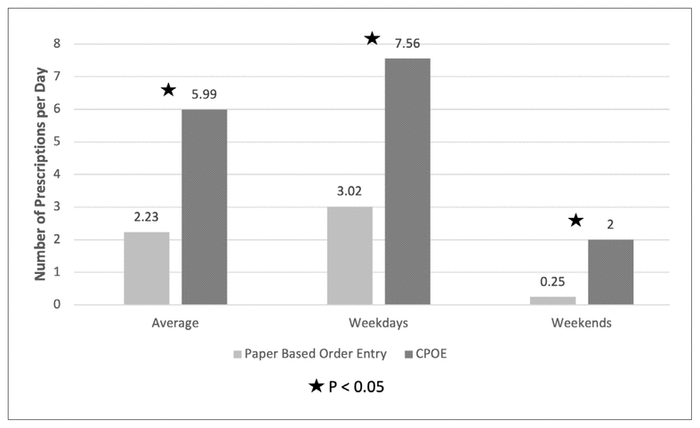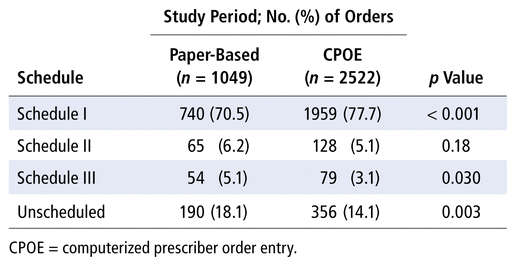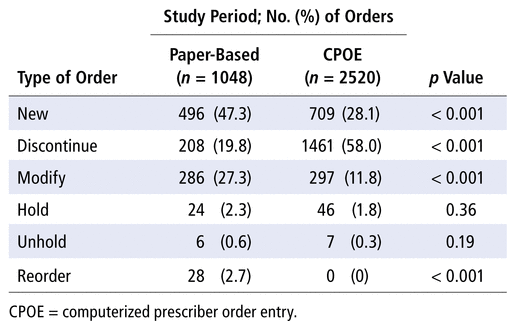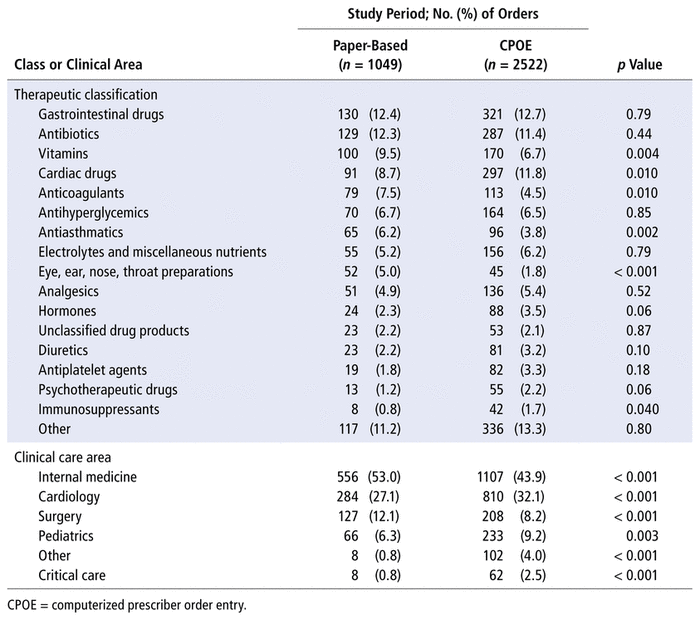
FIGURE 1 Mean number of prescriptions per clinical pharmacist per day in paper-based order entry and computerized prescriber order entry (CPOE) periods, according to days of the week.
Stephanie Metzger, Christopher Evernden, Tammy J Bungard, Gordon Bell, Mohamed A OmarDOI: https://doi.org/10.4212/cjhp.3302
ABSTRACT
Background
In Alberta, pharmacists are eligible to obtain additional prescribing authority (APA). At the University of Alberta Hospital, a transition was made from a paper-based prescriber order entry system to a computerized prescriber order entry (CPOE) system.
Objectives
The primary objective was to quantify any change in pharmacist prescribing after CPOE implementation. The secondary objective was to compare the paper-based and CPOE systems in terms of drug schedule, order type, medication class, and the pharmacist’s area of clinical practice.
Methods
A retrospective comparative review of pharmacist orders was completed using 2-week periods of data from each of the paper-based order entry system and the CPOE system, spaced 1 year apart (in January 2019 and January 2020).
Results
Pharmacists prescribed a mean of 3.76 (95% confidence interval 1.97–5.96) more orders per day within the CPOE system than in the paper-based system (p < 0.001). Schedule I medications accounted for a higher proportion of pharmacists’ prescriptions in the CPOE system than in the paper-based system (77.7% versus 70.5%, p < 0.001). In terms of order type, discontinuation orders accounted for a much higher proportion of pharmacists’ orders in the CPOE system than in the paper-based order entry system (58.0% versus 19.8%, p < 0.001).
Conclusions
This study showed that a CPOE system resulted in more use of APA by pharmacists, with schedule I medications accounting for a higher proportion of pharmacists’ prescriptions. With the CPOE system, pharmacists used their prescribing privileges to discontinue a higher proportion of orders than was the case with the paper-based system. Therefore, the CPOE system is a potential facilitator of pharmacist prescribing.
KEYWORDS: pharmacist, prescribing, computer, medical order entry systems
RÉSUMÉ
Contexte
En Alberta, les pharmaciens peuvent obtenir des pouvoirs de prescription supplémentaires (PPS). À l’hôpital de l’Université de l’Alberta, le système de saisie des ordonnances est passé d’un système sur papier à un système de saisie électronique des ordonnances (SSEO) par les prescripteurs.
Objectifs
L’objectif principal consistait à quantifier tout changement dans la prescription des pharmaciens après la mise en place du SSEO. L’objectif secondaire visait à comparer le système sur papier et le SSEO en matière d’annexe des médicaments, de type d’ordonnance, de catégorie de médicament et de domaine de pratique clinique du pharmacien.
Méthodes
Un examen comparatif rétrospectif des ordonnances des pharmaciens a été réalisé à l’aide de périodes de données de 2 semaines provenant de chacun des systèmes (papier et électronique), avec un intervalle d’un an (janvier 2019 et janvier 2020).
Résultats
Les pharmaciens prescrivaient en moyenne 3,76 (intervalle de confiance à 95 % 1,97–5,96) ordonnances de plus par jour avec le SSEO qu’avec le système sur papier (p < 0,001). La part des ordonnances de médicaments de l’annexe I était plus importante avec le SSEO qu’avec le système sur papier (77,7 % contre 70,5 %, p < 0,001). En ce qui concerne le type d’ordonnance, la part des ordonnances de cessation était beaucoup plus élevée avec le SSEO qu’avec le système de saisie sur papier (58,0 % contre 19,8 %, p < 0,001).
Conclusions
Cette étude a démontré un plus grand recours au PPS lorsque les pharmaciens utilisaient un SSEO et les médicaments de l’annexe I représentant une proportion plus élevée des ordonnances. Avec le SSEO, les pharmaciens ont utilisé leur pouvoir de prescription pour interrompre une part plus élevée d’ordonnances que ce n’était le cas avec le système sur papier. Le SSEO est donc un facilitateur potentiel de la prescription par les pharmaciens.
MOTS CLÉS: pharmacien, prescription, informatique, systèmes d’entrée des ordonnances par les
Since 2007, pharmacists in Alberta have been able to obtain additional prescribing authorization (APA), which allows them to prescribe nearly all provincially regulated drugs that require a prescription (i.e., schedule I drugs), on the basis of their own assessments. Use of APA in the hospital practice setting differs from APA use in the community, as a hospital pharmacist must have APA to order any medication independently, including medications that could be dispensed by a community pharmacist without a prescription.1 Without APA, a hospital pharmacist would require authorization or a cosignature from an authorized prescriber to order any medication, regardless of the medication schedule.
In Alberta hospitals, most pharmacists have obtained APA.2 A 2015 survey determined that hospital-based pharmacists who were working in oncology and had APA prescribed for about half of the patients under their care. Most of these prescriptions were for antibiotics or anticoagulant drugs, and pharmacists were most often adjusting medication doses based on renal function or clinical assessment.3 A cross-sectional study of electronic orders placed by hospital pharmacists in Calgary, Alberta, conducted in 2017, showed that 90% of hospital pharmacists used their prescribing authority, and they averaged 11.3 initial access prescriptions per pharmacist monthly.2 Fully half of the orders they placed were for discontinuation of medications.2
Since 2007, a number of Canadian studies have demonstrated the benefits of APA in community settings. Having patients see a prescribing pharmacist allowed for better control of risk factors in stroke patients,4 better control of blood glucose levels and hemoglobin A1C in patients with diabetes,5 better blood pressure control,6 a higher rate of cure for urinary tract infection,7 and a reduction in cardiovascular events.8 In contrast, there is a lack of evidence for the benefit of pharmacists prescribing in hospital settings.
In 2019, the University of Alberta Hospital in Edmonton implemented a computerized prescriber order entry (CPOE) system called Connect Care (Epic Systems Corporation). This new system drastically changed the process of prescribing from a written order entry system to a computerized system. To date, there are no data on how CPOE systems may influence pharmacist prescribing. The transition to Connect Care at the University of Alberta Hospital presented an opportunity to analyze the correlation between CPOE and pharmacist prescribing. It has also provided insight for pharmacy and interdisciplinary teams that are considering CPOE implementation into how CPOE systems and pharmacist prescribing may be related. As such, the purpose of this study was to determine whether pharmacist prescribing practices changed after the implementation of CPOE.
The primary objective of this study was to compare pharmacist prescribing rates before and after implementation of the CPOE system. The secondary objectives were to compare various aspects of prescribing before and after implementation of CPOE, specifically, therapeutic class and schedule of prescribed medications, clinical care area of prescribing pharmacists, and type of order.
The study was a retrospective comparative review of medication orders prescribed by pharmacists with APA in a tertiary care hospital. All paper-based orders from January 15 to 28, 2019 (scanned to the BD Pyxis Connect system, Becton, Dickinson and Company), and pharmacist-prescribed CPOE orders from January 15 to 28, 2020 (processed in the Connect Care system), at the University of Alberta Hospital were reviewed. The period January 15–28 was chosen to balance pharmacist vacation scheduling and seasonal factors. The data collection start date of January 2020 for the CPOE group of prescriptions was 3 months after the CPOE system was launched, and was chosen to ensure that pharmacists had sufficient time to develop proficiency with the system. This period was also before the COVID-19 pandemic had affected hospital bed occupancy rates in Alberta, where elective surgeries were cancelled beginning March 18, 2020.9
Ethics approval was obtained from the Research Ethics Board (Pro00104379). The need for informed consent was waived.
Three data sources were used for this study. The first data source was BD Pyxis Connect, the system in which medication orders were scanned and stored at the University of Alberta Hospital before implementation of the CPOE system; this system was used to collect data for the paper-based order entry period of the study. In this system, prescribers wrote the prescriptions on order sheets, which were scanned and stored for pharmacy order verification. The scanned orders remained in the system after pharmacy order verification and dispensing of the medication. All scanned orders within the study time frame that met the inclusion criteria were entered into the data collection form for the study, which was prepared using Research Electronic Data Capture (REDCap) data collection software.
The second data source was the health care charting system Connect Care, introduced at the University of Alberta Hospital in November 2019. Connect Care contains all elements of the patient chart, including medication orders. Data for the CPOE group of prescriptions were obtained from Connect Care reports. More specifically, one of the authors (S.M.) used Connect Care to run separate reports for all medication orders prescribed, held, and discontinued by University of Alberta Hospital pharmacists. These data were entered into the same REDCap data collection tool as used for the paper-based order entry period.
The third data source was archived pharmacist schedules, which were used to determine the clinical practice area of each pharmacist.
Any medication order prescribed by a University of Alberta Hospital pharmacist for an inpatient during either of the specified study periods was included. Orders were excluded if they were verbal orders received from a nonpharmacist prescriber or pharmacist suggestion orders with a cosignature from a nonpharmacist prescriber. Orders made by pharmacists in the dispensary and pharmacists in training were also excluded, as were orders for laboratory investigations and nonmedicinal products.
The primary outcome was the relative numbers of pharmacist orders per clinical pharmacist shift (7.75 h) over the 2 study periods (data from Pyxis Connect, January 15–28, 2019, for paper-based order entry; data from Connect Care, January 15–28, 2020, for CPOE), overall and categorized according to weekdays and weekends.
Four secondary outcomes were used to determine differences in proportionate pharmacist prescribing patterns before and after CPOE implementation. First, each medication order in the 2 study periods was classified by medication schedule (schedule I, schedule II, schedule III, or unscheduled), which determines whether a prescription or pharmacist assessment is required for a drug to be sold in a community pharmacy. Schedule I medications must have a prescription to be dispensed. Schedule II and III medications can be sold only when a pharmacist is present, and schedule II medications must be kept behind the counter. “Unscheduled” medications can be sold at any store with or without a pharmacist present. Drug schedules are determined by the National Association of Pharmacy Regulatory Authorities10 and the Alberta College of Pharmacy.11 Second, we reported proportionate differences in the order type (new order, order modification, or immediate order discontinuation). Modified orders were subsequently sorted according to the type of order modification: change to administration instructions, change in duration of therapy, change in dose, or “other”. Third, we sorted medications by medication class (e.g., gastrointestinal, antibiotics), as per the First Data Bank Therapeutic Classification System, the classification criteria used by the Connect Care system. Fourth, the orders were proportionally analyzed by the prescribing pharmacist’s clinical care area (e.g., internal medicine, surgery). These clinical care areas were adapted from those used by Saunders and others2 and were intentionally kept broad to preserve the confidentiality of pharmacists at the research location.
Saunders and others2 reported that 64 293 orders were placed by 172 pharmacists in 1 year, which corresponded to 17 new orders per pharmacist per month and about 31 total orders per pharmacist per month. There are approximately 25 full-time clinical pharmacists working at the University of Alberta Hospital each day, accounting for differences in weekday and weekend staffing. Therefore, we expected to collect 775 orders in each period of the study. With a standard deviation of 5 orders, collecting data from 775 orders in each period would provide 95% power to detect a difference between the groups. Data collection was stopped after 2 weeks because more than the predicted sample size was obtained.
The analysis included t tests to determine whether there was a significant difference in mean number of total orders prescribed per clinical pharmacist before and after CPOE implementation. For all secondary outcomes, a Z test was performed to determine whether there was a significant difference in proportion of orders placed in each group before and after CPOE implementation. Statistical significance was determined by p values less than 0.05.
A total of 1049 orders screened for the period January 15 to 28, 2019, met the inclusion criteria for the paper-based order entry group of prescriptions. In this period, pharmacists prescribed 2.23 orders per clinical pharmacist shift (standard deviation [SD] 1.35). The number of prescriptions per clinical pharmacist shift was higher on weekdays than on weekends (3.02 [SD 0.42] and 0.25 [SD 0.29], respectively) (Figure 1). A total of 2522 orders screened for the period January 15 to 28, 2020, met the inclusion criteria for the CPOE group of prescriptions. In this period, pharmacists prescribed 5.99 orders per clinical pharmacist shift (SD 2.98). This group also had more prescriptions per clinical pharmacist shift on weekdays than on weekends (7.56 [SD 1.03] and 2.00 [SD 2.35], respectively). Pharmacists prescribed a mean of 3.76 more orders per shift after implementation of the CPOE system than with the paper-based order entry system (95% confidence interval 1.97–5.96, p < 0.001).
|
| ||
|
FIGURE 1 Mean number of prescriptions per clinical pharmacist per day in paper-based order entry and computerized prescriber order entry (CPOE) periods, according to days of the week. | ||
Pharmacists prescribed a higher proportion of schedule I drugs after implementation of CPOE (70.5% with paper-based system versus 77.7% with CPOE system, p < 0.001) and lower proportions of schedule III drugs (5.1% with paper-based system versus 3.1% with CPOE system, p = 0.030) and unscheduled drugs (18.1% with paper-based system versus 14.1% with CPOE system, p = 0.003) (Table 1).
TABLE 1 Proportional Differences in Orders by Drug Schedule in Paper-Based and CPOE Study Periods

There were notable differences in the types of orders prescribed (Table 2). Pharmacists prescribed lower proportions of new and modified orders after CPOE implementation and a higher proportion of immediate discontinuation orders. The largest category of orders in the paper-based order entry period consisted of new orders (47.3%), whereas the majority of orders in the CPOE period were discontinuation orders (58.0%). The proportion of modified orders was higher with the paper-based order entry system than the CPOE system (27.3% versus 11.8%, p < 0.001). Modified orders were further analyzed by modification type (Figure 2). There was a significantly higher proportion of dose changes in the paper-based order entry period (77.7% with the paper-based system versus 74.7% with the CPOE system, p < 0.001), and a higher proportion of duration changes in the CPOE period (2.5% with the paper-based system versus 11.1% with the CPOE system, p < 0.001). Differences in the proportions of administration instruction modifications and “other” modifications were not statistically significant (Figure 2).
TABLE 2 Proportional Differences in Type of Order in Paper-Based and CPOE Study Periods

|
| ||
|
FIGURE 2 Modification types in paper-based and computerized prescriber order entry periods, expressed as proportion of all modifications. | ||
There were significant differences in proportionate prescribing patterns for many of the medication classes before and after CPOE implementation (Table 3). The 3 medication classes with the highest proportion of prescriptions in the paper-based order entry period were gastrointestinal drugs, antibiotics, and vitamins. Gastrointestinal drugs and antibiotics remained among the top 3 in the CPOE period, with the third being cardiovascular drugs. There were also differences in the proportions of orders placed by pharmacists in various clinical care areas before and after CPOE implementation (Table 3). Despite the statistically significant differences between the CPOE and paper-based periods, internal medicine and cardiology pharmacists represented the top 2 categories of prescribers both before and after CPOE implementation, whereas critical care pharmacists represented the lowest category of prescribers in both periods.
TABLE 3 Proportional Differences in Therapeutic Classification and Clinical Care Area

To our knowledge, this is the first study comparing pharmacist prescribing between a paper-based order entry system and a CPOE system. According to data for the primary outcome, pharmacists used their prescribing privileges significantly more often after the Connect Care CPOE system was implemented. Pharmacists also prescribed a higher proportion of schedule I medications within the CPOE system than the paper-based order entry system. Pharmacists used their prescribing authority to discontinue a higher proportion of orders using the CPOE system than in the paper-based order entry system and prescribed a lower proportion of new orders in the CPOE system. There were some proportional differences in therapeutic classification of medications and clinical care area before and after CPOE implementation, but these findings were less clinically significant.
Overall, these findings suggest that CPOE may be a facilitator of pharmacist prescribing to full scope. There are a number of potential reasons for this result. First, the convenience of placing orders in a computerized system rather than writing out orders by hand may have contributed. Second, many pharmacists have computer access on their clinical unit, which means the CPOE and all of the patient information that it contains are more readily available to inform pharmacist prescribing and to facilitate convenient order entry than is the case with a paper chart being used by many team members. Third, Connect Care includes a secure chat feature that allows members of the care team to contact each other directly. This feature allows pharmacists to easily communicate with the interprofessional team when prescribing, which is a requirement for pharmacist prescribing, according to the Alberta College of Pharmacy Standards of Practice.11 Finally, Connect Care was a relatively new system at the time of study, and practitioners may have made mistakes when ordering medications. Pharmacists may be prescribing more in the CPOE system because of the need to amend these errors.
The main reason for the difference in numbers of orders before and after CPOE implementation was the drastic increase in discontinuation orders during the CPOE period of the study. Pharmacists may have been responsible for more discontinuation orders in the CPOE period because Connect Care has a best possible medication history (BPMH) feature that autopopulates medications from the patient’s electronic health record and previous hospital visits. However, the information in the system does not always accurately reflect the patient’s home medication list, and pharmacists are likely the providers who will reconcile these discrepancies, which presumably involves the use of discontinuation orders. A high proportion of discontinuation orders was also noted by Saunders and others,2 who collected data on pharmacist prescribing habits in a CPOE system and noted that 50% of the orders placed were for discontinuation of medications. Despite the lower proportion of new orders in the CPOE system, due to the increased proportion of discontinuation orders, there was a higher total number of new orders in the CPOE period (709 versus 496), which further supports the idea that the CPOE system facilitates pharmacist prescribing.
In terms of medication classification, gastrointestinal medications and antibiotics were among the most frequently prescribed medication classes in both periods, which is consistent with data from previous studies.2 Findings regarding clinical care practice area were somewhat consistent with data from the previous study,2 in which internal medicine and surgical pharmacists had the most prescriptions and intensive care pharmacists the least.
This study had some limitations. First, pharmacist documentation was not accessed, so details supporting the medication orders could not be obtained. A chart review would have allowed us to analyze whether new medications ordered by pharmacists represented continuation of home medications or initial prescriptions. It also would have provided the rationale for modifications made by pharmacists (e.g., renal dose adjustments, correction of errors). Second, this study was a single-centre evaluation and consequently may lack generalizability to other centres. However, Epic Systems software has been implemented at many other hospitals in Canada, and these results may be of use to those centres.
In this study, pharmacists generated more prescriptions in a CPOE system than a paper-based order entry system at the University of Alberta Hospital, with a higher proportion of schedule I medications prescribed. This finding could be due to convenience and easy access to the CPOE system, as well as the CPOE system’s ability to facilitate interprofessional collaboration. More data are needed to determine whether increased pharmacist prescribing in the CPOE system correlates with improved patient outcomes.
1 Alberta Health Services Executive Committee. Pharmacist prescribing of medication orders [policy]. Alberta Health Services; 2013 [cited 2020 Sep 9]. Available from: https://extranet.ahsnet.ca/teams/policydocuments/1/clp-pharmacist-prescribing-of-medications-hcs-15-policy.pdf
2 Saunders S, Dersch-Mills D, Mysak T, Romonko-Slack L, Chernick A, Lazarenko G, et al. CAPABLE: Calgary zone usage of additional prescribing authorization by pharmacists in an inpatient setting: review of the prescribing landscape and environment. Res Social Admin Pharm. 2020;16(3):342–8.
Crossref
3 Heck T, Gunther M, Bresee L, Mysak T, Mcmillan C, Koshman S. Independent prescribing by hospital pharmacists: patterns and practices in a Canadian province. Am J Health Syst Pharm. 2015;72(24):2166–75.
Crossref
4 McAlister FA, Majumdar SR, Padwal RS, Fradette M, Thompson A, Buck B, et al. Case management for blood pressure and lipid level control after minor stroke: PREVENTION randomized controlled trial. CMAJ. 2014;186(8):577–84.
Crossref PubMed PMC
5 Al Hamarneh YN, Charrois T, Lewanczuk R, Tsuyuki RT. Pharmacist intervention for glycaemic control in the community (the RxING study). BMJ Open. 2013;3(9):e003154.
Crossref PubMed PMC
6 Tsuyuki RT, Houle SKD, Charrois TL, Kolber MR, Rosenthal MM, Lewanczuk R, et al. Randomized trial of the effect of pharmacist prescribing on improving blood pressure in the community: the Alberta clinical trial in optimizing hypertension (RxACTION). Circulation. 2015; 132(2):93–100.
Crossref PubMed
7 Beahm NP, Smyth DJ, Tsuyuki RT. Outcomes of urinary tract infection management by pharmacists (RxOUTMAP): a study of pharmacist prescribing and care in patients with uncomplicated urinary tract infections in the community. Can Pharm J (Ott). 2018;151(5):305–14.
Crossref
8 Tsuyuki RT, Al Hamarneh YN, Jones CA, Hemmelgarn BR. The effectiveness of pharmacist interventions on cardiovascular risk: the multicenter randomized controlled RxEACH trial. J Am Coll Cardiol. 2016;67(24):2846–54.
Crossref PubMed
9 Novel coronavirus (COVID-19) information for Albertans. Alberta Health Services; [cited 2020 Sep 10]. Available from: https://www.albertahealthservices.ca/topics/Page16944.aspx#changes
10 What are the National Drug Schedules? National Association of Pharmacy Regulatory Agencies; [cited 2022 Nov 21]. Available from: https://www.napra.ca/national-drug-schedules/national-drug-schedules-program/what-are-the-national-drug-schedules-nds/
11 Standards of practice. Alberta College of Pharmacy; [cited 2021 Jun 3]. Available from: https://abpharmacy.ca/standards-practice
Competing interests: For activities unrelated to this article, Tammy Bungard has received an unrestricted quality improvement grant from Pfizer and has served (on a voluntary basis) as cochair of the Patient & Family Committee of Thrombosis Canada; she has also received Lovenox and Innohep cards, which allow drugs to be supplied to patients unable to afford their medications. No other competing interests were declared. ( Return to Text )
Funding: None received. ( Return to Text )
Canadian Journal of Hospital Pharmacy, VOLUME 76, NUMBER 2, Spring 2023